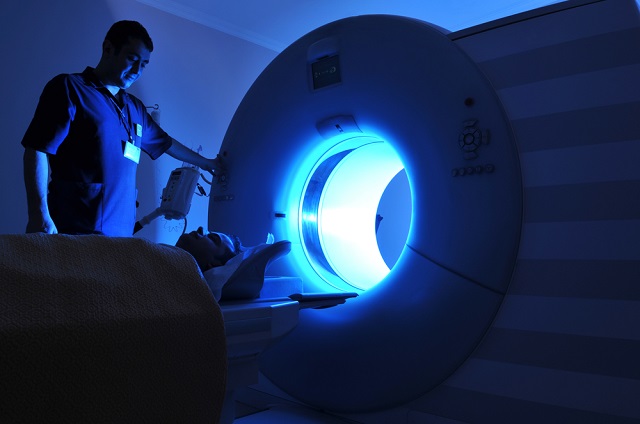A novel method of measuring magnetic resonance has been developed for use in lab-on-chip technology. The method uses a microscopic garnet crystal which nanomechanically twists in response to an external magnetic field which can be observed with spectroscopy. Current methods, which rely on electronic induction are not as easily miniaturized as the new technique.
 A magnetic resonance imaging (MRI) machine, which depends on measurement by electronic induction. Levent Konuk | Shutterstock
A magnetic resonance imaging (MRI) machine, which depends on measurement by electronic induction. Levent Konuk | Shutterstock
Magnetic resonance facilitates next-generation magnetic studies in the field of interdisciplinary science and device development. In this novel magnetic resonance technique, the signal with which the resonance is observed is a nanomechanical twisting movement that is easily observed using light.
Current approaches measure magnetic resonance via an electrical signal that is produced by induction which can be diffuclt to perform on small devices. In contrast, the latest method is suitable for the development of miniaturizable mechanical devices. This new technology, developed by researchers led by Professor Mark Freeman at the University of Alberta, can be used to develop a complete magnetic sensor unit that can easily be integrated on a 1cm2 chip.
To most, a gem so tiny would be worthless, but to us, it’s priceless. It was the perfect testbed for this new method.
Our discovery makes the case that magnetic resonance is in essence both a mechanical and magnetic phenomenon on account of magnetic dipoles possessing angular momentum.
Magnetism needs better spin doctors than it has had. Everything in the world is magnetic on some level, so the possibilities for scientific applications of this new technique are endless
Prof. Mark Freeman - University of Alberta
There are immediate applications in physics, Earth sciences, and engineering, but we have only looked at electron spin resonance. Proton spin resonance is the next big step that will open up applications in chemistry and biology.
Prof. Mark Freeman - University of Alberta
This latest advancement paves the way for developing compact and miniaturized platforms for a wide range of applications such as in energy, health care, space exploration and environmental monitoring.
In order for the technology to become commonplace the physicists intend to share their data on how to implement their new method of measuring magentic resonance. They hope this will feed the ongoing research dedicated to magnetic resonance.
The team has decided not to patent their new technique, but rather publish their results in a scientific journal. This would give an open-source access to other scientists, and may help develop the field further. The idea behind this strategy was to ensure that researchers are not pressurized when performing these kinds of innovative discoveries.
According to Freeman, chip-based mechanical devices are extremely small, and hold the potential to deliver excellent performance. Over time, electronic sensors integrated in space exploration probes, smart phones and other similar devices will soon be replaced by these miniaturizable mechanical devices.
Ultimately, the way science makes progress is through people sharing discoveries. It’s an elegant solution to a challenging problem, simple but not obvious,” stated Freeman, “Working in condensed matter physics is like having the best seat at an awe-inspiring parade of progress.
Prof. Mark Freeman - University of Albert
The research paper titled “Torque-Mixing Magnetic Resonance Spectroscopy,” was published in the journal 'Science'.